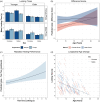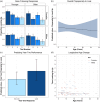Individual differences in sociocognitive traits in semi-free-ranging rhesus monkeys (Macaca mulatta)
- PMID: 38961748
- PMCID: PMC11698962
- DOI: 10.1002/ajp.23660
Individual differences in sociocognitive traits in semi-free-ranging rhesus monkeys (Macaca mulatta)
Abstract
Characterizing individual differences in cognition is crucial for understanding the evolution of cognition as well as to test the biological consequences of different cognitive traits. Here, we harnessed the strengths of a uniquely large, naturally-living primate population at the Cayo Santiago Biological Field Station to characterized individual differences in rhesus monkey performance across two social cognitive tasks. A total of n = 204 semi-free-ranging adult rhesus monkeys participated in a data collection procedure, where we aimed to test individuals on both tasks at two time-points that were one year apart. In the socioemotional responses task, we assessed monkeys' attention to conspecific photographs with neutral versus negative emotional expressions. We found that monkeys showed overall declines in interest in conspecific photographs with age, but relative increases in attention to threat stimuli specifically, and further that these responses exhibited long-term stability across repeated testing. In the gaze following task we assessed monkeys' propensity to co-orient with an experimenter. Here, we found no evidence for age-related change in responses, and responses showed only limited repeatability over time. Finally, we found some evidence for common individual variation for performance across the tasks: monkeys that showed greater interest in conspecific photographs were more likely to follow a human's gaze. These results show how studies of comparative cognitive development and aging can provide insights into the evolution of cognition, and identify core primate social cognitive traits that may be related across and within individuals.
Keywords: comparative development; emotional processing; gaze following; primate cognition.
© 2024 The Author(s). American Journal of Primatology published by Wiley Periodicals LLC.
Conflict of interest statement
The authors declare no conflict of interest.
Figures




Similar articles
-
Intranasal oxytocin selectively attenuates rhesus monkeys' attention to negative facial expressions.Psychoneuroendocrinology. 2013 Sep;38(9):1748-56. doi: 10.1016/j.psyneuen.2013.02.011. Epub 2013 Mar 13. Psychoneuroendocrinology. 2013. PMID: 23490074 Free PMC article.
-
Short-term testosterone manipulations do not affect cognition or motor function but differentially modulate emotions in young and older male rhesus monkeys.Horm Behav. 2014 Nov;66(5):731-42. doi: 10.1016/j.yhbeh.2014.08.016. Epub 2014 Oct 13. Horm Behav. 2014. PMID: 25308086 Free PMC article.
-
Rhesus monkeys show human-like changes in gaze following across the lifespan.Proc Biol Sci. 2016 May 11;283(1830):20160376. doi: 10.1098/rspb.2016.0376. Proc Biol Sci. 2016. PMID: 27170712 Free PMC article.
-
A decade of theory of mind research on Cayo Santiago: Insights into rhesus macaque social cognition.Am J Primatol. 2016 Jan;78(1):106-16. doi: 10.1002/ajp.22362. Epub 2014 Dec 29. Am J Primatol. 2016. PMID: 25556543 Review.
-
Individual differences in emotionality: social temperament and health.Am J Primatol. 2011 Jun;73(6):507-15. doi: 10.1002/ajp.20870. Epub 2010 Aug 17. Am J Primatol. 2011. PMID: 20717999 Free PMC article. Review.
References
-
- Alberts, S. C. , Altmann, J. , Brockman, D. K. , Cords, M. , Fedigan, L. M. , Pusey, A. , Stoinski, T. S. , Strier, K. B. , Morris, W. F. , & Bronikowski, A. M. (2013). Reproductive aging patterns in primates reveal that humans are distinct. Proceedings of the National Academy of Sciences, 110, 13440–13445. - PMC - PubMed
-
- Almeling, L. , Hammerschmidt, K. , Sennhenn‐Reulen, H. , Freund, A. M. , & Fischer, J. (2016). Motivational shifts in aging monkeys and the origins of social selectivity. Current Biology, 26, 1744–1749. - PubMed
-
- Almeling, L. , Sennhenn‐Reulen, H. , Hammerschmidt, K. , Freund, A. M. , & Fischer, J. (2017). Social interactions and activity patterns of old Barbary macaques: Further insights into the foundations of social selectivity. American Journal of Primatology, 79, e22711. - PubMed
-
- Alwall, N. , Johansson, D. , & Hansen, S. (2010). The gender difference in gaze‐cueing: Associations with empathizing and systemizing. Personality and Individual Differences, 49, 729–732.
MeSH terms
Grants and funding
LinkOut - more resources
Full Text Sources

